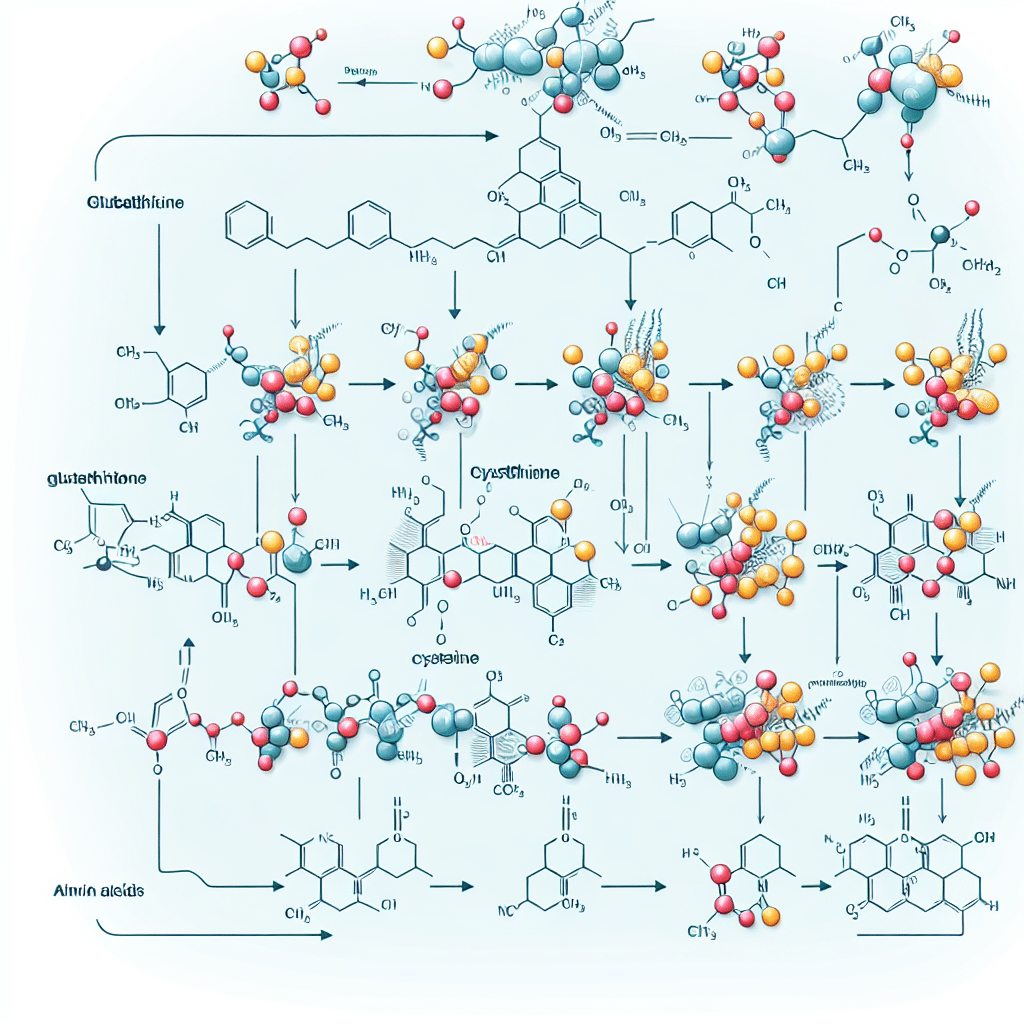Glutathione Cap from Cysteine: How It Works
-
Table of Contents
- Glutathione Synthesis from Cysteine: Understanding the Process
- The Significance of Cysteine in Glutathione Synthesis
- Glutathione Biosynthesis: A Step-by-Step Overview
- First Step: Formation of γ-Glutamylcysteine
- Second Step: Addition of Glycine
- Factors Influencing Glutathione Levels
- Health Benefits of Glutathione
- Supplementation and Boosting Glutathione Levels
- Conclusion: The Importance of Cysteine in Glutathione Synthesis
- Discover ETprotein’s High-Quality Protein Products
Glutathione Synthesis from Cysteine: Understanding the Process

Glutathione, often referred to as the master antioxidant, is a tripeptide composed of three amino acids: glutamine, cysteine, and glycine. It plays a crucial role in protecting cells from oxidative stress, detoxifying harmful substances, and maintaining the immune system. The synthesis of glutathione from cysteine is a complex process that is vital for maintaining optimal health. In this article, we will delve into the intricacies of how glutathione is capped from cysteine and the implications of this process for human health.
The Significance of Cysteine in Glutathione Synthesis
Cysteine is a sulfur-containing amino acid that is a key component in the synthesis of glutathione. Its thiol (sulfhydryl) group is responsible for the antioxidant properties of glutathione. The availability of cysteine often limits the production of glutathione within the body, making it a rate-limiting factor.
- Role of Cysteine: Cysteine serves as the sulfur donor in the formation of glutathione, contributing to its chemical structure and function.
- Enzymatic Reactions: Two main enzymes, glutamate-cysteine ligase (GCL) and glutathione synthetase (GS), catalyze the formation of glutathione from its constituent amino acids.
- Regulation of Synthesis: The body regulates the synthesis of glutathione by modulating the activity of GCL, ensuring that glutathione levels are maintained within a healthy range.
Glutathione Biosynthesis: A Step-by-Step Overview
The biosynthesis of glutathione is a two-step process that involves the sequential addition of amino acids to form the tripeptide. Here’s how it works:
First Step: Formation of γ-Glutamylcysteine
The enzyme GCL catalyzes the first step, where glutamate and cysteine are combined to form γ-glutamylcysteine. This reaction is ATP-dependent and forms the peptide bond between the gamma-carboxyl group of glutamate and the amino group of cysteine.
Second Step: Addition of Glycine
In the second step, GS adds glycine to the C-terminal of γ-glutamylcysteine to form glutathione. This reaction also requires ATP and completes the synthesis of the tripeptide.
Factors Influencing Glutathione Levels
Several factors can affect the body’s ability to synthesize glutathione:
- Dietary Intake: Consuming foods rich in cysteine, such as whey protein, poultry, eggs, and garlic, can support glutathione synthesis.
- Age: Glutathione levels naturally decline with age, which may contribute to the aging process and age-related diseases.
- Health Status: Chronic diseases, stress, and exposure to toxins can deplete glutathione levels, making supplementation necessary in some cases.
- Genetic Factors: Genetic variations in the enzymes involved in glutathione synthesis can affect individual levels of this antioxidant.
Health Benefits of Glutathione
Glutathione is involved in numerous physiological processes and offers a range of health benefits:
- Antioxidant Protection: Glutathione neutralizes free radicals and reactive oxygen species, protecting cells from oxidative damage.
- Detoxification: It conjugates with toxins, facilitating their excretion from the body.
- Immune Function: Glutathione enhances the function of immune cells and has anti-inflammatory properties.
- Cellular Health: It plays a role in cell proliferation, apoptosis, and the maintenance of mitochondrial function.
Supplementation and Boosting Glutathione Levels
While the body can synthesize glutathione, certain conditions may necessitate supplementation or strategies to boost its levels:
- Direct Supplementation: Glutathione supplements are available, but their effectiveness can vary due to absorption challenges.
- Precursor Supplementation: Supplementing with cysteine or N-acetylcysteine (NAC) can provide the necessary building blocks for glutathione synthesis.
- Lifestyle Changes: Regular exercise, adequate sleep, and reducing exposure to toxins can help maintain healthy glutathione levels.
Conclusion: The Importance of Cysteine in Glutathione Synthesis
In conclusion, cysteine is a critical component in the synthesis of glutathione, a powerful antioxidant that supports numerous bodily functions. Understanding how glutathione is capped from cysteine provides valuable insights into maintaining health and preventing disease. By ensuring adequate intake of cysteine-rich foods or considering supplementation, individuals can support their body’s natural antioxidant defenses and promote overall well-being.
Discover ETprotein’s High-Quality Protein Products
If you’re looking to enhance your health and support glutathione synthesis, consider exploring ETprotein’s range of protein products. Their offerings include high-quality, organic, and non-GMO protein powders that can provide the amino acids necessary for optimal glutathione production. With a focus on purity and efficacy, ETprotein’s products are an excellent choice for those seeking to boost their antioxidant levels and improve their health.
About ETprotein:
ETprotein, a reputable protein and L-(+)-Ergothioneine (EGT) Chinese factory manufacturer and supplier, is renowned for producing, stocking, exporting, and delivering the highest quality organic bulk vegan proteins and L-(+)-Ergothioneine. They include Organic rice protein, clear rice protein, pea protein, clear pea protein, watermelon seed protein, pumpkin seed protein, sunflower seed protein, mung bean protein, peanut protein, and L-(+)-Ergothioneine EGT Pharmaceutical grade, L-(+)-Ergothioneine EGT food grade, L-(+)-Ergothioneine EGT cosmetic grade, L-(+)-Ergothioneine EGT reference grade and L-(+)-Ergothioneine EGT standard. Their offerings, characterized by a neutral taste, non-GMO, allergen-free attributes, with L-(+)-Ergothioneine purity over 98%, 99%, cater to a diverse range of industries. They serve nutraceutical, pharmaceutical, cosmeceutical, veterinary, as well as food and beverage finished product distributors, traders, and manufacturers across Europe, USA, Canada, Australia, Thailand, Japan, Korea, Brazil, and Chile, among others.
ETprotein specialization includes exporting and delivering tailor-made protein powder and finished nutritional supplements. Their extensive product range covers sectors like Food and Beverage, Sports Nutrition, Weight Management, Dietary Supplements, Health and Wellness Products, and Infant Formula, ensuring comprehensive solutions to meet all your protein needs.
As a trusted company by leading global food and beverage brands and Fortune 500 companies, ETprotein reinforces China’s reputation in the global arena. For more information or to sample their products, please contact them and email sales(at)ETprotein.com today.














